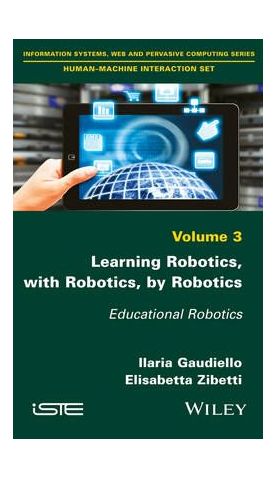אנו משתמשים ב-Cookies כדי לשפר את החוויה שלך. כדי לקיים ההנחיה החדשה של e-Privacy, עלינו לבקש את הסכמתך להגדיר את ה-Cookies. קבלת מידע נוסף.
757.00 ₪
Learning Robotics, with Robotics, by Robotics - Educational Robotics
757.00 ₪
ISBN13
9781786300997
יצא לאור ב
London
זמן אספקה
21 ימי עסקים
עמודים
260
פורמט
Hardback
תאריך יציאה לאור
20 בספט׳ 2016
The relationship between technological and pedagogical innovation has recently created a new field of research at the crossroads between Psychology, Educational Sciences and Artificial Intelligence: Educational Robotics (ER).
The relationship between technological and pedagogical innovation has recently created a new field of research at the crossroads between Psychology, Educational Sciences and Artificial Intelligence: Educational Robotics (ER). Through analysis of the achievable educational goals based on the technological status and specific learning modes of different types of robots, it is possible to define three pedagogical paradigms: learning robotics, learning with robotics, and learning by robotics. In this book we address these three paradigms through three themes: human representations of robots, the acceptance and trust shown when interacting with a humanoid, and learning favored by the development and programming of robots in an educational context. These themes allow the authors to fully explore, define and delimit this novel field of research for future application in educational and social contexts. Finally, the book discusses contributions and limitations which have emerged from different methodologies of research, potential educational applications, and concepts of human robot interaction for the development of the above paradigms.
| עמודים | 260 |
|---|---|
| פורמט | Hardback |
| ISBN10 | 1786300990 |
| יצא לאור ב | London |
| תאריך יציאה לאור | 20 בספט׳ 2016 |
| תוכן עניינים | Foreword ix Preface xiii Introduction xix Chapter 1 Learning Robotics: Users' Representation of Robots 1 1.1 Introduction: the ontological and pedagogical status of robots 1 1.2 What do we mean by robot representation? 3 1.2.1 The place of robots in our common-sense ontology 3 1.2.2 Categories: essentialist versus graded 4 1.2.3 The NOC hypothesis 6 1.2.4 Shifting between the different pedagogical roles of a robot 7 1.2.5 How do we investigate robot representations and the impact of learning robotics on these representations? 8 1.3 Study 1: Robot representation 9 1.3.1 Aims and rationale 9 1.3.2 Hypotheses 10 1.3.3 Method 12 1.4 Results 17 1.4.1 Which representation of robots for familiar and unfamiliar students? 17 1.4.2 The living and non-living items most frequently associated with robots (pre-questionnaire) 18 1.4.3 Gradation in robot categorization: essentialist versus non-essentialist stance (pre-questionnaire) 19 1.4.4 The educational roles most frequently envisaged for robots (pre-questionnaire) 20 1.4.5 Gradation in the educational roles envisaged for a robot (pre-questionnaire) 20 1.4.6 The impact of building and programming a robot on students' judgment about the ontological status of robots 21 1.4.7 The impact of robot making on graded versus all-or-nothing categorization 23 1.4.8 Does familiarity with robots influence their categorization? 26 1.4.9 Dichotomous versus multiple categorization of robots 28 1.4.10 The impact of robot making on the educational roles envisaged for robots 29 1.4.11 The impact of robot making on shift between the educational roles envisaged for robots 31 1.4.12 Does previous experience influence the educational role attributed to robots? 32 1.5 Discussion 34 1.6 Conclusions, limits and perspectives 38 Chapter 2 Learning with Robotics: Functional and Social Acceptance of Robots 43 2.1 Functional and social acceptance of robots 43 2.2 Trust as a fundamental indicator of acceptance 49 2.2.1 Commonly used measures of human robot trust 49 2.2.2 Conformation as an innovative measure of human robot trust 51 2.2.3 Factors influencing robot trust 52 2.3 Study 2: robot acceptance 56 2.3.1 Aims and rationale 56 2.3.2 Method 59 2.4 Results 69 2.4.1 Do participants conform their answer more to iCub's answer in the functional task than in the social task? (H1) 69 2.4.2 Do participants who conform to iCub in the social task also conform in the functional task? (H2) 71 2.4.3 Does the imagined HRI scenario influence trust in iCub? (H3) 71 2.4.4 Is there a correlation between negative attitudes to the robot's social influence and the trust in the robot's social savvy? (H4) 74 2.4.5 Is there a correlation between the human DFC and the trust in the robot's functional and social savvy? 74 2.5 Discussion 76 2.6 Conclusions 83 Chapter 3 Learning by Robotics: The Impact of Educational Robots on Learning 87 3.1 Combining RBI and inquiry-based science 87 3.2 IBSE and the four dimensions of learning 93 3.2.1 The cognitive dimension 95 3.2.2 The affective dimension 97 3.2.3 The social dimension 98 3.2.4 The meta-cognitive dimension 99 3.2.5 Self-regulation 101 3.2.6 RBI and inquiry-based learning 105 3.3 Study 3: impacts of ER on learning 114 3.3.1 Aims and rationale 114 3.3.2 The RObeeZ project 115 3.3.3 Hypotheses 122 3.3.4 Experimental design 123 3.4 Results 128 3.4.1 Are the subject-specific knowledge and competencies of pupils enhanced at the end of RObeeZ project? 128 3.4.2 Are pupils' transversal competencies enhanced at the end of the project? 129 3.4.3 Does the combination of RBI and IBSE have an impact on the four dimensions of learning? 130 3.5 Discussion 136 Conclusion and Perspectives 143 Appendices 153 Appendix 1 155 Appendix 2 159 Appendix 3 163 Appendix 4 169 Appendix 5 177 Bibliography 181 Index 223 |
| זמן אספקה | 21 ימי עסקים |



Login and Registration Form